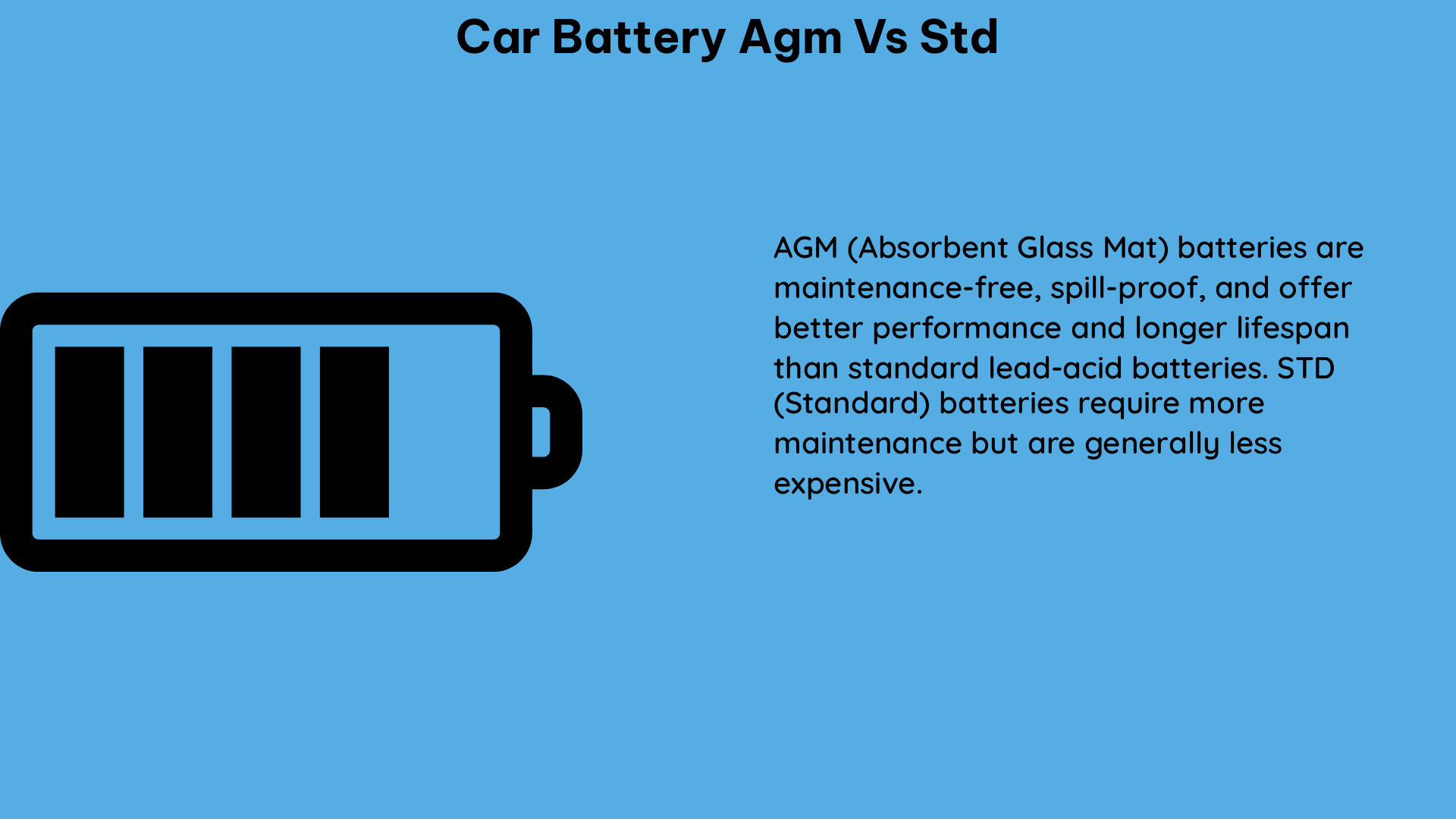When it comes to choosing the right car battery, the decision between an Absorbent Glass Mat (AGM) battery and a standard lead-acid battery can be a crucial one. Both types of batteries have their own unique characteristics, advantages, and disadvantages, and understanding the differences can help you make an informed choice that best suits your vehicle’s needs.
Identifying AGM vs. Standard Lead-Acid Batteries
The first step in distinguishing an AGM battery from a standard lead-acid battery is to look for specific labeling and physical characteristics. AGM batteries will typically have “AGM” or “Non-Spillable” printed on the battery’s casing or label, while standard lead-acid batteries will not have any such special markings.
Another key difference is the construction of the batteries. AGM batteries are sealed and do not require regular maintenance, such as adding water to the cells, unlike standard lead-acid batteries. This makes AGM batteries more convenient and less prone to leaks or spills.
Technical Specifications and Performance

When it comes to technical specifications, AGM batteries offer several advantages over standard lead-acid batteries:
-
Internal Resistance: AGM batteries have a lower internal resistance, which allows for faster charging and better performance under heavy loads. This makes them a better choice for applications that require high-current draw, such as in-car entertainment systems, power tools, or emergency equipment.
-
Vibration and Impact Resistance: AGM batteries are less sensitive to vibration and impact, making them a suitable choice for applications in construction equipment, off-road vehicles, motorcycles, and race cars.
-
Lifespan: AGM batteries typically have a longer lifespan compared to standard lead-acid batteries. While a well-maintained standard lead-acid battery may last between one and two years, an AGM battery can last three years or more with proper care.
-
Charging Sensitivity: AGM batteries are more sensitive to overcharging, which can lead to damage if not properly charged. They require a regulated charger to prevent this issue, whereas standard lead-acid batteries are less sensitive to overcharging.
Cost Considerations
AGM batteries are generally more expensive than standard lead-acid batteries, with prices ranging from 20% to 50% higher. However, the longer lifespan and improved performance of AGM batteries can make them a cost-effective choice in the long run, especially for applications that require reliable and consistent power delivery.
Installation and Mounting
When installing an AGM battery in your vehicle, it is essential to ensure that the battery is securely mounted to prevent damage from vibration and impact. AGM batteries are also spill-proof, making them a good choice for installations in enclosed spaces, such as the trunk or under a seat.
It’s important to note that AGM batteries are often smaller in size compared to standard lead-acid batteries, so you may need to purchase new battery hold-downs to ensure a secure fit.
Charging and Maintenance
As mentioned earlier, AGM batteries are more sensitive to overcharging and require a regulated charger to prevent damage. It’s crucial to follow the manufacturer’s recommendations for charging and maintaining your AGM battery to ensure optimal performance and longevity.
In contrast, standard lead-acid batteries are less sensitive to overcharging and may not require the same level of attention, but they do require regular maintenance, such as adding water to the cells.
Applications and Recommendations
AGM batteries are well-suited for a variety of applications, including:
- Construction and off-road vehicles
- Motorcycles and race cars
- Vehicles with high-current draw, such as in-car entertainment systems or emergency equipment
- Installations in enclosed spaces, such as the trunk or under a seat
Standard lead-acid batteries, on the other hand, may be a more cost-effective choice for general automotive applications where the battery is not subjected to heavy loads or vibration.
When choosing between an AGM battery and a standard lead-acid battery, it’s important to consider the specific needs of your vehicle and application, as well as the long-term cost-effectiveness of the investment.
Conclusion
In summary, the choice between an AGM battery and a standard lead-acid battery depends on your specific needs and requirements. AGM batteries offer several advantages, such as better performance under heavy loads, longer lifespan, and greater resistance to vibration and impact, but they are also more sensitive to overcharging and require a regulated charger. Standard lead-acid batteries, while less expensive, may not provide the same level of performance and reliability in certain applications.
By understanding the key differences between these two battery types, you can make an informed decision that will ensure the optimal performance and longevity of your vehicle’s electrical system.
References:
- How can I tell if this is a standard lead-acid battery or an AGM battery?
- Battery Basics
- AGM vs Standard Battery: Which is Better?
- Confirming AGM battery, not the standard
- AGM vs. Standard Battery: Which is Better for Your Car?

The lambdageeks.com Core SME Team is a group of experienced subject matter experts from diverse scientific and technical fields including Physics, Chemistry, Technology,Electronics & Electrical Engineering, Automotive, Mechanical Engineering. Our team collaborates to create high-quality, well-researched articles on a wide range of science and technology topics for the lambdageeks.com website.
All Our Senior SME are having more than 7 Years of experience in the respective fields . They are either Working Industry Professionals or assocaited With different Universities. Refer Our Authors Page to get to know About our Core SMEs.